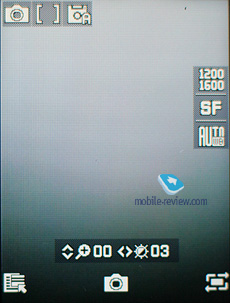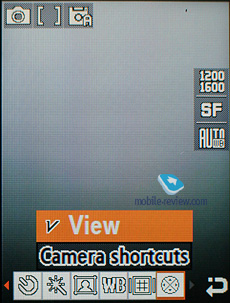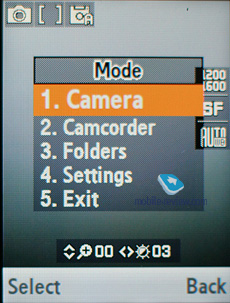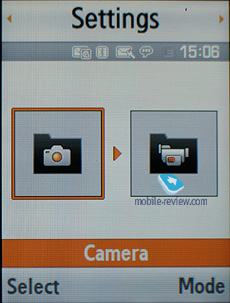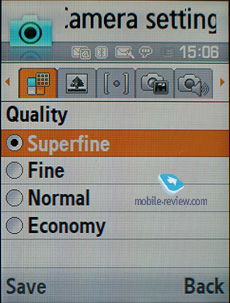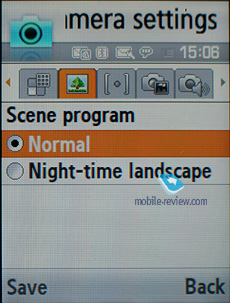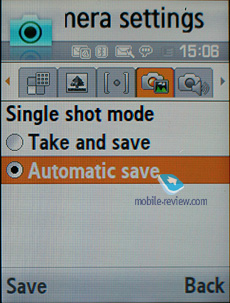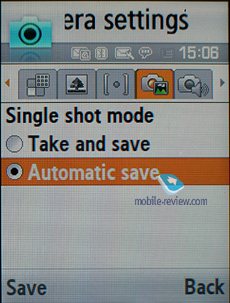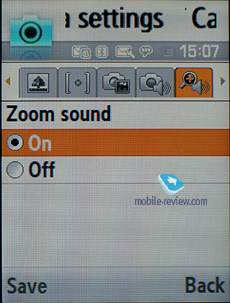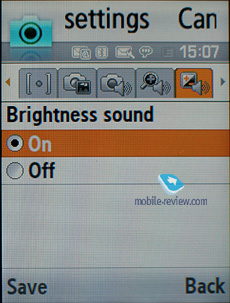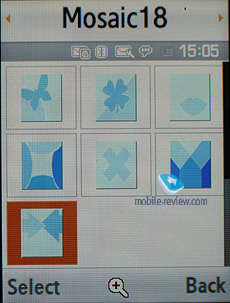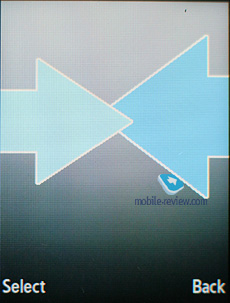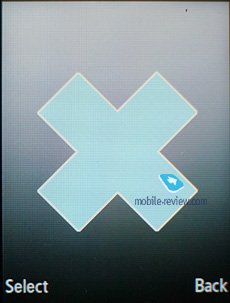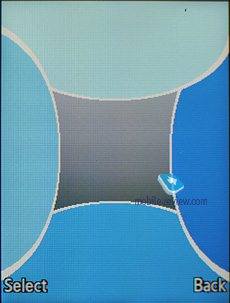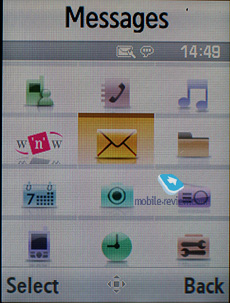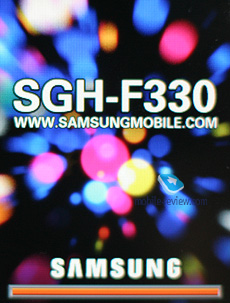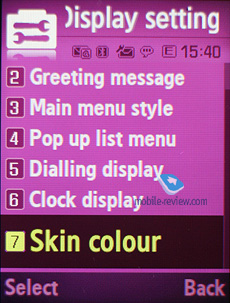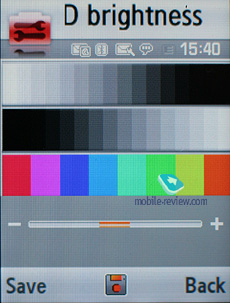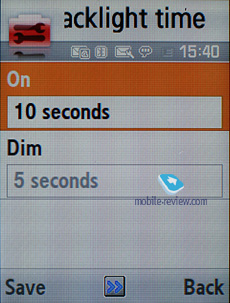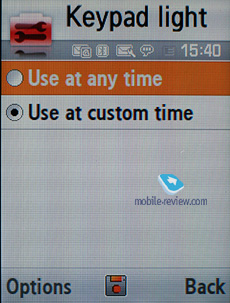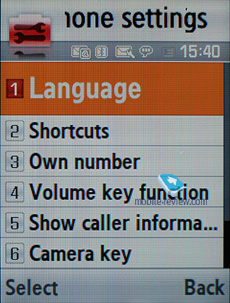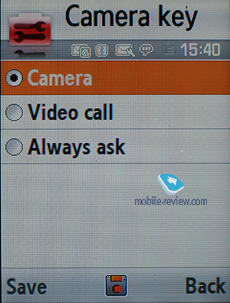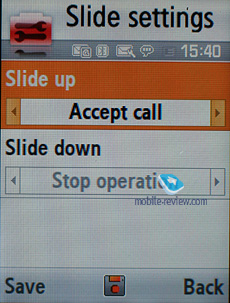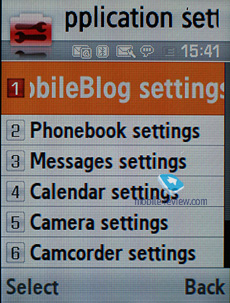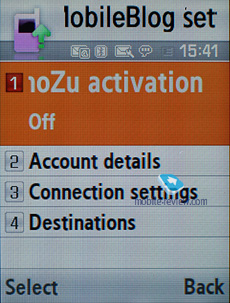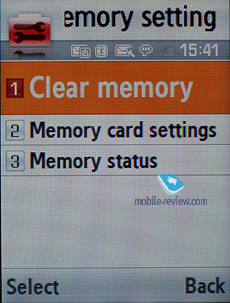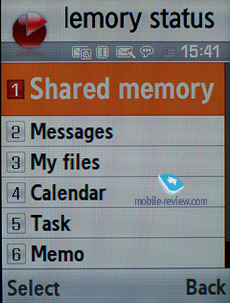|
|
Review of GSM/UMTS-handset Samsung F330
Live photos of the Samsung F330
Table of contents:
- Positioning
- Design, size, controls
- Display
- Keypad
- Battery
- USB, Bluetooth, connectivity
- Memory, memory cards
- Performance
- Camera
- Menu
- Applications
- WAP
- ÌÐ3-player
- Impressions
Sales package
- Handset
- Battery
- Wired stereo-headset
- USB data cable
- Software CD
- microSD memory card (1Gb, size and availability vary by region)
- User Guide
Positioning
The second device in the BeatZ line-up, unlike the Samsung i450, makes use of a standard hardware platform and Suwon’s software for 3G terminals. In fact, this is the good old Samsung G800 yet coming in a different wrapping and with a new camera. Also stemming from this is the fact that the F330’s sound quality is no different from the G800 or the U600, for it employs the same hardware solution, so you won’t hear much of a difference when using one and the same pair of earphones with these handsets.
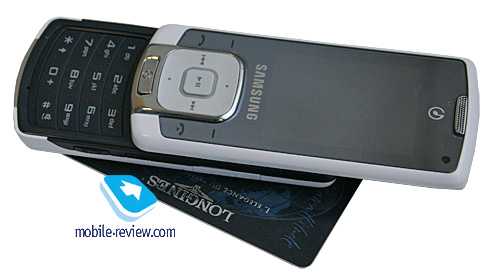
The only reason why the F330 saw release is that they needed to start the new music-heavy line-up with something. This way, over at Samsung they thought a mid-range phone with a knack for playing music should be pretty much standard, and so they didn’t put much effort into it. And the line taken by the manufacturer is rather straightforward – if music is the main focus, then the phone should come in a white iPod-esque casing and with a pair of decent earphones in the box. However what they rolled is in fact neither fish nor fowl.
While it packs all the traits of the U-series, it also retains a youth-aimed design, putting it in one league with less expensive offerings. The handset’s positioning is centered on music alone and the range of music-savvy devices. But does this range really exist, or it hasn’t gone beyond the company’s roadmap? Essentially, three members of the line-up are way too different to suppose that someone will actually be making a choice between them. The future sales of the F330 don’t look promising at all either. Its predecessors housed in the same form-factor have already proven this point – being not a fashion-savvy phone, the Samsung F330 can’t withstand the competition of Samsung’s own solutions. And those consumers looking to get a top-notch sonic experience are very likely to go for the Samsung i450.
All this means the only purpose of the F330’s release is to create an illusion of choice – nobody expects this model to do summersaults, hence it has only one available color scheme (white).
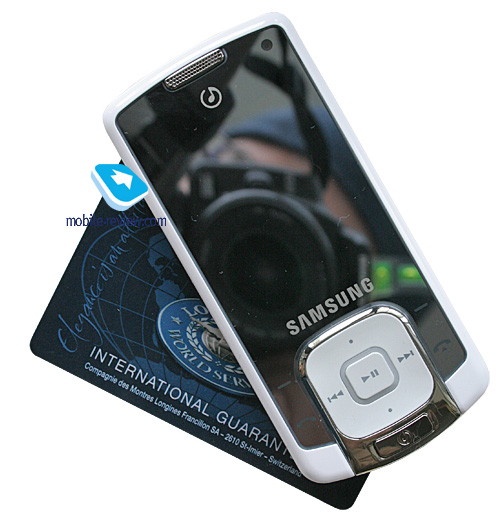
Back to the table of contents >>>
Design, size, controls
The handset comes in white plastic, no word on extra color schemes, and basically, they are very unlikely to appear. While the plastic on the F330 is glossy, it somewhat reminds us of, let’s be honest, not the best possible variation of Apple’s products.
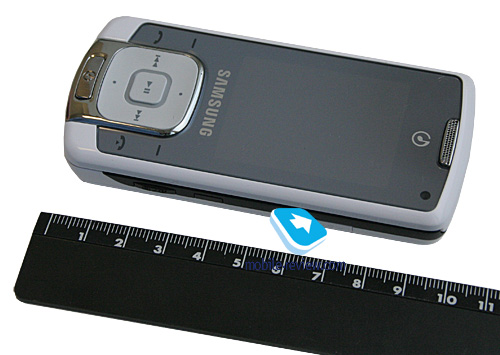
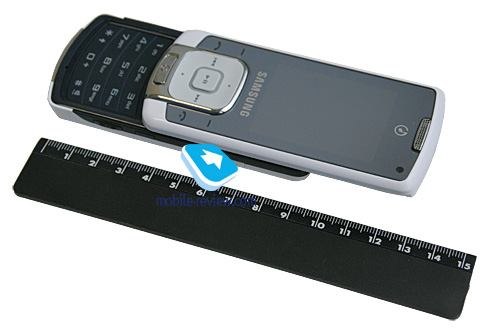
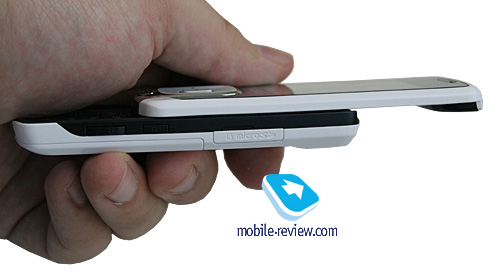
The plastic is susceptible to scuffs, however you won’t spot any deep scratches on it at a glance. The mirror-like front fascia gets covered with grease and fingerprints in no time, so be ready to carry a cleaning cloth on you to keep your device in pristine condition.
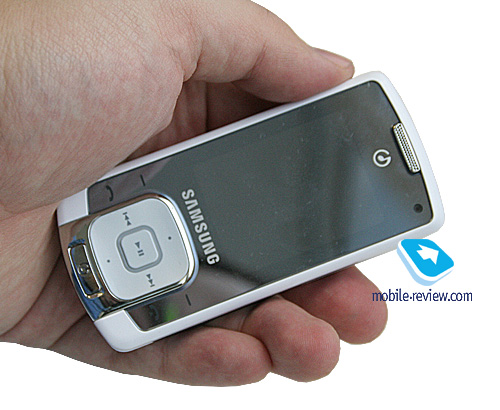
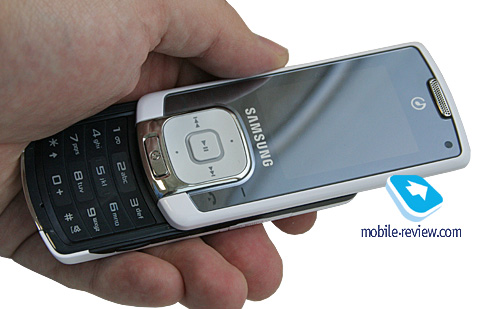
Topping the display is the forward-facing camera for video calls. The headset jack sits on the left hand side (wide interface port) and is covered by a plastic flap. Right next to it is the volume rocker and the application switch key (just like on any 3G device, with the F330 you can toggle between messages, calls and browsers in one touch – looks like multi-tasking abilities, while in fact it is nowhere near it).
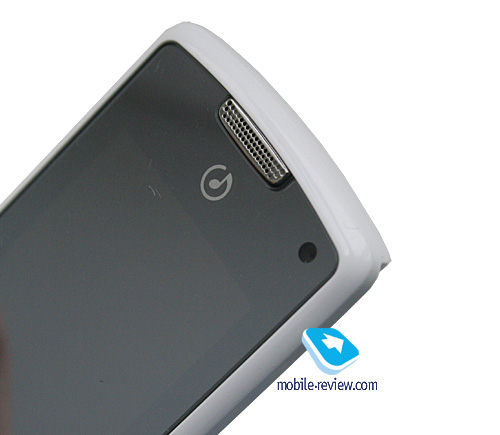

The right hand spine hosts the power button, the dedicated camera key and the microSD memory expansion slot. The lanyard eyelet is found on the bottom edge.
The F330 slides open and close with ease, all thanks to its spring loaded mechanism.

Back to the table of contents >>>
Display
The F330 comes preinstalled with a 2,1-inch, 240x320-pixel (32x43 mm) TFT display, capable of showing up to 262 K colors – all this allows it to show off a vibrant and juicy picture, and what is more, its color reproduction cannot be marred even by direct sunlight, even though it gets a tiny bit washed out in the sun after all.
The screen accommodates up to 8 text and 3 service lines. While the level of 8 text lines can be squeezed into just about any mode, when browsing web-pages you will get 15-20 lines of information on average. But it all depends on the font size you have picked.
Back to the table of contents >>>
Keypad
The F330 enjoys touch-sensitive controls for the functional keys. The letdowns of this solution don’t take a rocket scientist to figure out, but in this particular device, the ergonomics are crippled with the slightly protruding navigation button, meaning that every time you touch one of the flanking sensors, the phone will react immediately. This doesn’t do the F330 any justice – we were quite disappointed with its keypad’s performance.
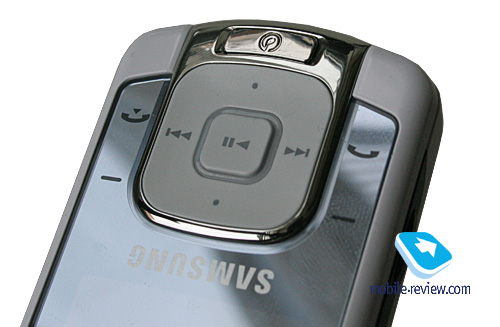
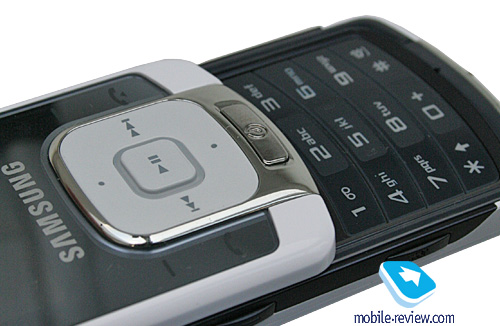
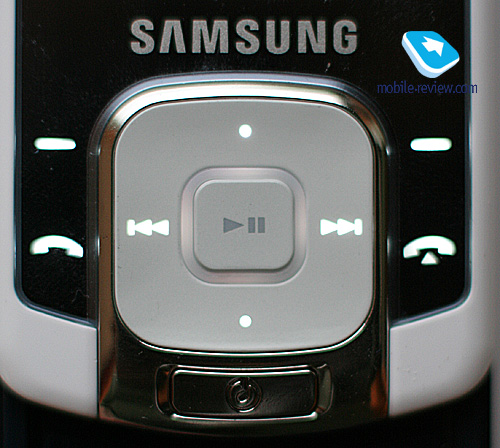
The F330 also packs a dedicated music button for launching/minimizing the music player in one touch.
The numeric keys are housed on a thin plastic slab and provide average travel distance, being pretty much usable. All buttons are lit in well-visible white.
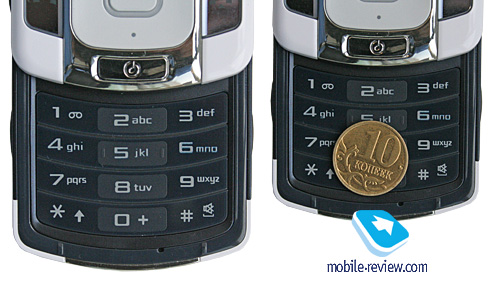
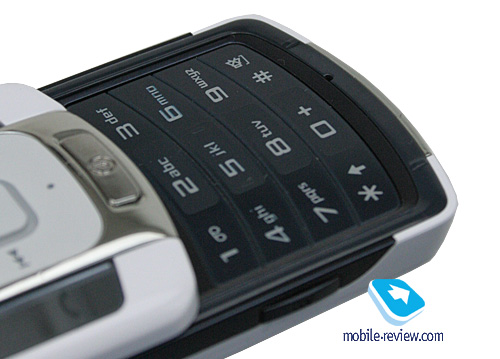
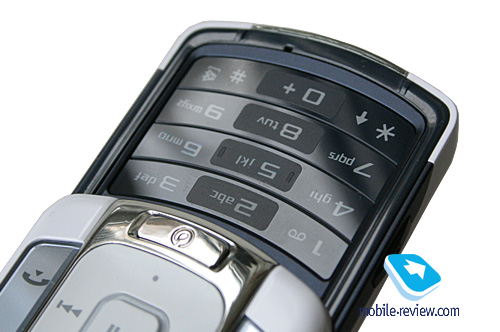
Back to the table of contents >>>
Battery
Surprisingly, the handset utilizes a 900 mAh Li-Ion battery. The manufacturer rates it as being good for up to 250 hours of standby and 2,5 hours of talk time. Within European networks the phone lasted around 2,5 days (one hour of calls total and regular use of its alarm clock). At the same time, in Moscow it managed to stay online for 2 days at 1,5 hours of calls. That’s why the F330 will stay up and running for at least 2 days with average load, however under certain circumstances you might squeeze up to 3 days of operation out of it. It takes the handset 1,5 hours to charge from empty to full. No higher-capacity cells are available for this model.
We got a shade more than 11 hours of continuous music with the F330 (cellular module enabled).
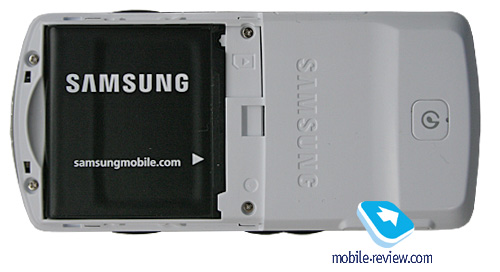
Back to the table of contents >>>
USB, Bluetooth, connectivity
Bluetooth. The model supports various profiles, such as Headset, Handsfree, Serial Port, Dial Up Networking, File Transfer, Object Push, Basic Printing, A2DP. EDR-enabled Bluetooth 2.0 is onboard. Headset management doesn’t allow us to have any quibbles with it, everything is standard here.
USB-connection. In the menu you may select one of three modes: Media, Mass Storage, Samsung PC Studio. No Modem mode available with the F330, there is even no such option in PC Studio. I hope it will come along a bit later.
While in the USB Mass Storage mode, the F330 shows up on the desktop without requiring you to install any additional drivers, so right after plugging in it’s ready to work. Data connection speeds top out at 2000-2200 Kb/s.
You won’t be able to use the F330’s Bluetooth connectivity along with USB – it will require you to disable Bluetooth regardless of its status (connected and transferring data or not), which is very awkward.
When connected to a PC via USB, the F330 automatically recharges itself.
HSDPA allows for extreme data speeds in UMTS networks – up to 3.6 Mb/s. There is also EDGE class 10 for GSM.
Back to the table of contents >>>
Memory, memory cards
The phone ships with 28 Mb of onboard memory – this storage space, give or take, is available to the user right out of the box. The memory card (hot-swappable) is displayed as a separate section, so you can’t access both memory types at a time. The F330 also comes with a file manager, enabling you to copy files to/from the memory card. In our test the handset had no problems handling a 2 Gb microSD memory card, whereas a 4 Gb unit remained unidentified.
Back to the table of contents >>>
Performance
Compared to other GSM-models, Samsung’s 3G handsets are somewhat better performers; however they aren’t too far ahead. Generally, Samsung is chasing the market on this front, for its devices come with slower CPUs and no full Java support. As it stands today, new applications can be uploaded only over the air (wap).
Faced off against Samsung G800, the F330 turns out to be a tad faster, however this advantage doesn’t make any difference.
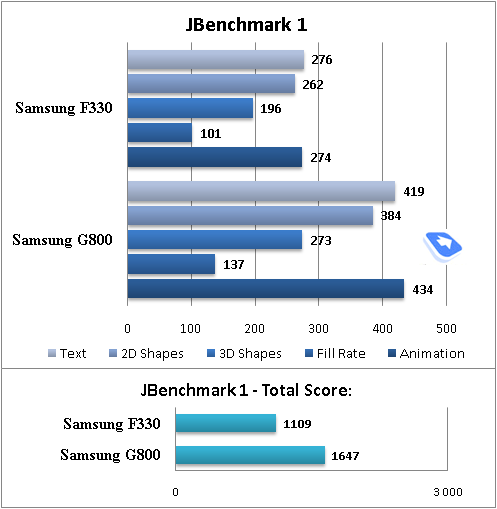
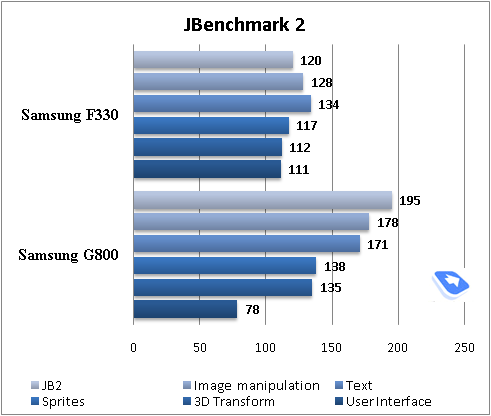
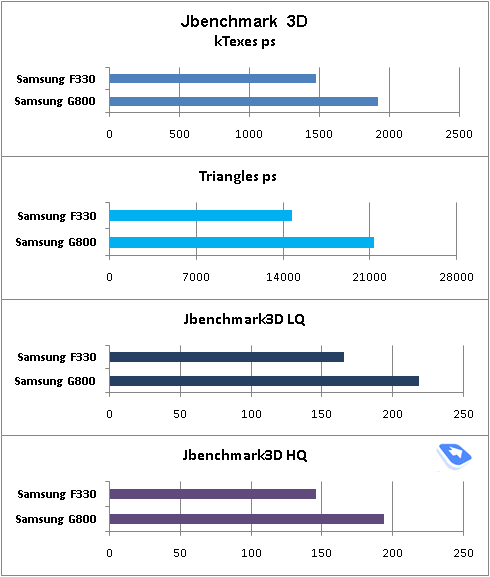
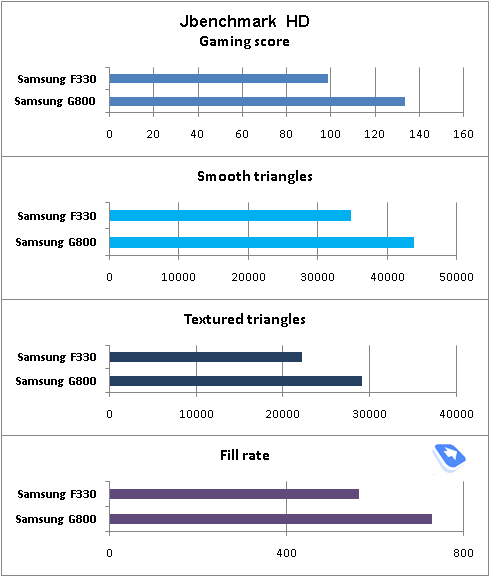
Back to the table of contents >>>
Camera
The handset comes packed with a 2 Mpix camera without auto focus (CMOS). The camera lens is mounted on the top slide, so you can start shooting only after zipping the F330 open. The image quality delivered by this handset is average or a bit higher, as long as it is daylight, but all in all, it has nothing to shout about.
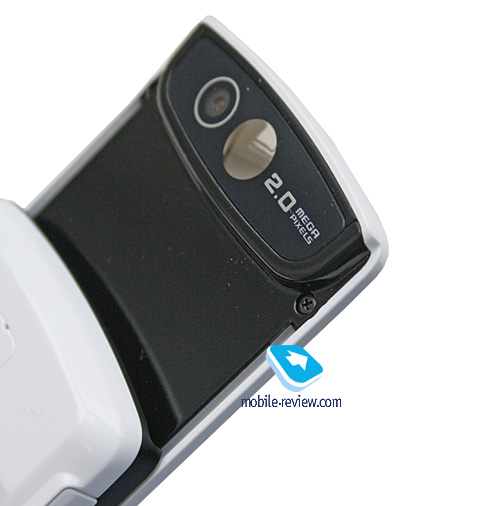
The following resolutions are supported:
- 1600x1200 pixels
- 1280x960 pixels
- 800x600 pixels
- 640x480 pixels
- 320x240 pixels
Four quality levels are available:
- Super Fine
- Fine
- Normal
- Economy
You better use the best quality settings available, since they won’t be all that bigger in size, but you will appreciate the boost in quality.
The user is presented with a couple of shooting modes as well:
- MultiShot – takes 6, 9 or 15 shots in a rapid succession
- Panorama – can be composed of 3 or 4 snaps. Just like with the Samsung G800, the phone will take all photos automatically and then stitch them together on its own. However it is not a rare occasion when it fails to do the things properly;
- Mosaic – your snap will be stitched from a batch of images, on top of that, you can pick of the 18 templates. At a glance, this is a totally useless features, but I found these images great for decorating my standby screen, when selected wallpapers displayed one after another. Single-piece images just don’t look as good there.
Speaking of the standard options you get with the F330, these are the White balance (Auto, Daylight, Incandescent, Fluorescent, Cloudy), frames for the resolution of 320x240 pixels, three effects (Black&White, Negative, Sepia). You won’t be able to adjust ISO, but the exposure settings are at your disposal instead. The handset also packs a x8 digital zoom, which proves to be pretty much worthless, though.
 |
 |
| (+) maximize, 1200x1600, JPEG |
(+) maximize, 1200x1600, JPEG |
 |
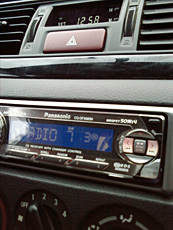 |
| (+) maximize, 1200x1600, JPEG |
(+) maximize, 1200x1600, JPEG |
 |
 |
| (+) maximize, 1200x1600, JPEG |
(+) maximize, 1200x1600, JPEG |
 |
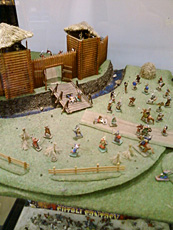 |
| (+) maximize, 480x640, JPEG |
(+) maximize, 480x640, JPEG |
 |
 |
| (+) maximize, 1200x1600, JPEG |
(+) maximize, 1200x1600, JPEG |
 |
 |
| (+) maximize, 1200x1600, JPEG |
(+) maximize, 1200x1600, JPEG |
 |
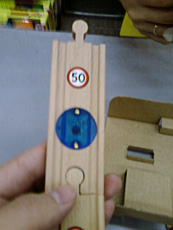 |
| (+) maximize, 1200x1600, JPEG |
(+) maximize, 1200x1600, JPEG |
 |
 |
| (+) maximize, 1200x1600, JPEG |
(+) maximize, 1200x1600, JPEG |
 |
 |
| (+) maximize, 1200x1600, JPEG |
(+) maximize, 1200x1600, JPEG |
Video. The device captures video in two resolutions – 240x320 pixels and 176x144 pixels at up to 15 FPS. Its video quality, however is nothing special.
Back to the table of contents >>>
Menu
The main menu is viewed as a grid (3x4) or a list. All sub-menus have horizontal lists - in the case of there being a sub-menu, you will see a pop-up list on the right of the highlighted item. You see which items are stored underneath, and once you press OK button, you will get there. When you lean the navigation key either left or right, you will be able to access the corresponding item immediately. Ergonomics of such solution is unquestionable, as you will have to make at least one key-press less. Also you can disable this view mode, so then the F330’s menu becomes just like any other menu system.
While surfing the menus you can take advantage of last item memorization in every sub-menu and the main menu. The Handset will “remember” which function you addressed last time, and will highlight it automatically next time you enter the same menu item. For example, if you had selected call list in main menu and done some operations in it, then the next time you enter main menu you will have it highlighted in first place. But that’s not all; once you access it again you will see that sub-menu item which was addressed last will be highlighted too. It seems to be a simple thing, but it is not present in handsets produced by any other manufacturer.
When hovering over one or another item in the list you will see it highlighted, and font size (which is big already) will be increased.
Shortcut number navigation is supported, but there are more ways to navigate the menu available in the F330. You can bind four different applications from the list, offered by manufacturer (you will not be able to bind java applications). There is no quick launch menu available in the F330 (uMenu).
Themes. The F330, unlike the Samsung E950, doesn’t allow you to pick own themes and tweak them – you can only use only the default themes. On the other hand, you can adjust the menu’s color scheme.
uWorld (formerly known as Living World). This is a selection of personal wallpapers for each country (major cities might get unique wallpapers in the future, though it is not quite evident). When you will be in Moscow you will see Kremlin wharf and triumphal arch in case you’re in Paris, as for London – house of parliaments, and so on. Besides graphical assignation manufacturer decided to modify wallpaper depending on time of day: in the morning you see sun, and in the evening you see blinding lights of Kremlin wharf, cars will have their headlights turned on.
Time is not the only event that can be morphed into graphics. For example network reception level: good signal – sky is blue, no signal or weak one – sky is covered with clouds. At first you don’t pay much attention to this tiny feature, but after a month you will look on the sky instead of the standard bar, information reads instantly.
For new messages, missed events, or alarm clocks there is a special way of displaying, and which is powered with standard, traditional pop-up window with text. In daytime, such events will be demonstrated with help of airplane that will fly through the sky, and in the evening that would be fireworks. Color will change according to event type. At a glance this system looks kind of complicated, especially during its description, but in reality it is crystal clear and understandable.
When dialing a number you will see a small image with main theme displayed and animation of the dialed number.
Phonebook
Contacts can be accessed by pressing right soft key; you will see a list that contains all entries from both SIM-card and phone’s memory. The second tab comprises contact groups, so that you can switch to them in no time. If there is an assigned image, its thumbnail will be shown in the list – when scrolling though your contact list, a thumbnail will be shown only for a currently selected entry, and if there is none set, the F330 will use a default smilie.
The field beneath the name is the default number, which can be picked manually from the list of submitted numbers for a particular contact. Quick name search by first letters is supported; there can be up to twenty of those, for any language. Once you press OK key you will go into detailed view of the selected entry. There you will see a thumbnail, if any. It can be an image, a photo or a video clip. Each entry can have up to 5 phone numbers of different types (mobile, office, home, fax other), one of them will be main number (by default it is the first one you entered). All fields are hardwired.
There are two lines for First Name and Last Name (search is performed only by the former), these fields get merged when displayed in the general list, and First Name comes first. For example Eldar Murtazin will be shown only in this order. Length of each field is 20 characters for any supported input language. You can also switch languages on the fly when entering a name.
All entries, regardless of language, are sorted out in the following way – all contacts with headings made in a local language (Russian, for example) go first and then those with names in English. This is rather convenient and handy list sorting system. Taking into account fast language switch option during the search, it’s clear that no language will spoil the experience of working with this phone. The list can’t be sorted by first or last name.
But let us return to the information entered for a contact. Apart from phone numbers, e-mail address (there may be several of them), a little text memo can be submitted on top of all that. Any music file (including MP3) can be picked as a ring tone for a contact. Three caller groups are provided by default with the possibility for creating any number of additional groups, setting a personal melody and image for each (by default there are three groups). SMS alerts are not customizable.
The phonebook is capable of holding up to 1000 contacts with filled in data fields. Even if all the available blanks are not used, the cap won’t get any bigger and will still make one thousand. It is possible to specify in the settings where all new numbers should be kept by default. There is also an option for moving entries from the SIM-card, although the reverse action is denied. According to the developers, PC (MS Outlook in particular) is best for data synchronization with the F330. Any contact in the form of SMS/MMS, mail message or other text file can be quickly sent through Bluetooth to another device. There are no problems with sending, and the phonebook entry gets beamed to another device, where it is read without any trouble.
The phonebook may contain a business card as well, though its structure copies all the fields found in a regular contact in the phone book.
There can be up to eight numbers in the fast dial list; separate numbers tied up with a single contact may appear on this list as well. The chosen entry (not of the phone number type) is displayed on the buttons as the subtitle.
You can create any number of caller groups, assign up to 20 contacts and customize them with a picture and tune.
On an incoming call, caller ID picture occupies not the entire screen, but only a part of it. However, it still takes up a considerable area. This isn’t great, given the display’s stellar specifications.
Call log
Each of the given lists contains up to 30 phone numbers. There is a combined list of all the last calls with an icon indicating call type. Pressing the navi-pad horizontally, you can switch quickly between the lists. The date and time of the calls with a special note on duration are displayed in the extended view for separate entries. Calls from/to one number are grouped up, so that the number standing next to the call specifies total number of calls made. In order to access duration data you will need to call up detailed information on desired item. As always, the overall time of the calls and their cost can be viewed in this menu (in the case that the service has been enabled).
For individual numbers you can arrange a black list, which will reject all calls coming from these contacts.
Messaging
Much like other makers, over at Samsung they have forgone that artificial division into SMS-MMS types – you just start composing a message, and only then, depending on the contents, it is attributed to SMS or MMS. The menu still holds an option for switching message into MMS mode (for example when you need to send only text, but to an e-mail address, without calling up the bundled client).
The phone memory can hold up to as many as 500 messages; the handset supports EMS standard compatible with Nokia Smart Messaging. T9 text input comes in handy and is easy to use. While choosing recipient, you can either select a telephone number from your contacts or pick one from the call lists or groups. All messages are manageable, this means you are at liberty to move a certain number to your black list, in order to make sure all messages coming from that phone number will be deleted automatically; possibility for moving messages to any own folder is also at your disposal. For e-mail you can move not only addresses to the blacklist, but unwanted subjects as well.
There are no size restrictions set on received messages, though an outgoing message’s size is limited to 295 KB. As for additional services available with the F330, message rejection and message retrieval type options are onboard. All messages are stored in general dynamic memory, the same goes for e-mails.
Also there is a useful function for sending SOS-messages – when activated, should you find yourself in an emergency, after pressing the volume key four times, the message «I am in emergency. Please help me» will be sent to contacts submitted earlier, all incoming calls from these numbers upon sending the emergency message will be picked up automatically. Recipients (not more than 5), as well as number of Repeats may be set up manually, while text of the SOS-message is not customizable.
The bundled mail client is standard in all its components – 5 accounts and the maximum of 100 incoming messages; attachments are also handled by the phone, though there are also several caps – there’s no way you can receive a file more than 500 Kb big, or send one with size exceeding 300 kb. Received files can be viewed via the bundled browser. The F330 doesn't support html in emails, which breaks formatting of most letters you receive, so they become really awkward to read. The mail client found in Samsung-branded phones is now falling behind those embedded in Nokia’s and Sony Ericsson’s solutions.
Organizer
The phone’s memory can store as many as 100 events of one type – meeting. There are other event types as well, like anniversary and holiday, with the maximum capability of 50 events for each type. The F330 can also hold up to 20 high-priority events and the same number of private entries.
Day and time as well as end time of an event are indicated for each entry. Alert signal and its duration can be adjusted to your liking; repeatable events are available for setting up (repeat time is also manageable as well as the exceptions). The weekly and the monthly calendar views are very convenient with each type of the event having its own color.
Speaking of the organizer’s shortcomings, I cannot overlook the fact that when typing date and time for an event, the end time doesn’t change, which badly hurts its ease of use – other manufacturers make the due time shift automatically (by default any event takes one hour).
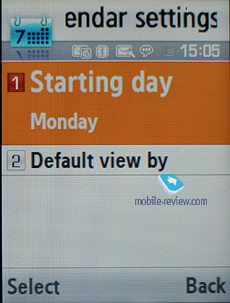
Back to the table of contents >>>
Applications
FM-radio. You can store up to 20 radio stations in the memory; the range of available frequencies is 87.5-108 MHz. Also, you can enjoy auto-tuning, but particular channels cannot have own names attached – they are always shown as the frequency numbers. The radio can work in handsfree mode, plus it enables you to set it up as an alarm clock, but regardless of how you are going to use it, a plugged-in headset is a must, since it doubles as an antenna. The radio implementation is fine, although it doesn’t pick up all stations equally well, but on balance, it is quite competent in comparison to other vendors’ offerings. The radio can be minimized.
RDS here displays only the station’s name in the general list, no advanced options available.

Voice recorder. You can record up to several hours of voice memos with the number of files being unlimited. Basically, limitations on recording duration are set by the user himself, though length of a single recording cannot exceed 1 hour. All the files are stored in a separate folder in the memory bank. The recorder performs well during lectures, conferences and presentations – I could even say that it is a partial substitute for a digital tape recorder.
World time is displayed for two chosen cities.

Calculator It divides, multiplies, subtracts and adds and does several more things – quite enough for a mobile calculator.
With the converter, you can operate with different units of measurements as well as with a number of currencies.
Countdown time and stopwatch have no bells and whistles.
Memo – standard text notes.
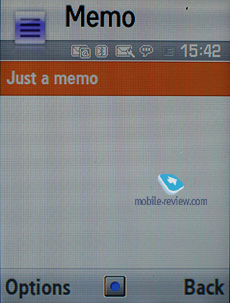
RSS Reader. This is a stand-alone utility for RSS feeds. However, it would make more sense if the RSS Reader was bound up with the web-browser, but this is not the case with the F330. This way, RSS links are not picked up by the browser, or sent directly to the application. You will need to manually submit a channel address in this app to subscribe, or enter a web address and let the application try to find an RSS channel on it.
While uploading your news feed, the F330 can upload text, as well as video and audio files, and it is up to you to set the size limit (by default – 5 Mb per file). Regrettably, there are no scheduled feed updates available, thus you will need to refresh the feed manually every time you need hot news.
Obviously with this application Samsung is having a first go at this field, and the truth is, it is not really functional or appealing the way it is in the F330. Similar solutions found in the phone from other makers pack more punch and are easier to manage.
Java World. The handset comes pre-installed with 6 games, of which 2 are fully functional (Bobby Carrot, Time Rider II), and four are demo-versions (limited by time or levels). These demos are quite fetching, these can be Asphalt 2 Urban GT, Midnight Pool, Minigolf, Tetris and so on.
The memory volume assigned for Java-applications is unlimited, at that you can remove any of the pre-installed games and upload new over the air (via WAP). Heap size can’t exceed 2 Mb, while the application can’t go over 1 Mb.
Back to the table of contents >>>
WAP
The handset comes with a wap-browser version 2.0 (NetFront 3.4), where apart from JavaScript support, fonts scaling (three types), Smart-Fit (single-column view), full-screen mode (all controls are hidden), page caching, they have embedded a new feature – on-screen ‘mouse’ pointer. Much like Nokia’s S60-powered handsets and Opera Mini, you can view pages with a tiny navigation window displayed. The browser itself packs a lot of goods under the hood and will be appreciated by most users.
Unlike the previous models, which used Picsel Viewer for browsing office documents, the F330 employs the bundled browser for these purposes. What we really like about it is that the user can perform local search within a document (any language). While it is a tad sluggish compared to Picsel Viewer, it is still pretty easy to handle. Personally, I couldn’t make up my mind on which solution I liked better – both of them have their strengths and weaknesses.
Back to the table of contents >>>
ÌÐ3-player
The integrated mp3 player, supporting random, sequential and cyclic playback, is available on the phone. Mp3 files can be uploaded onto the handset both directly over Bluetooth and through the synch application or Windows Media Player. There are no limitations on tags and names of music files. Bitrates are not something that really matters either – the handset easily deals with all available formats and supports WMA, AAC, eAAC, eAAC+.
The title of the currently played back track is displayed as well as the number of the remaining tracks. No equalizer is embedded in the F330. Your tracks can be played through the stereo headset as well as the speakerphone. The volume bar has 10 scales on it. And of course the user can make up their own playlists. Player can work in minimized mode – in this case the display will show current track title and music controls, which is a good thing.
The player boasts the following filters: all tracks, recently players, most popular, artists, albums, genres and composers. The F330 also sports Album Arts support.
Speaking of new options, the player has obtained the rating system, enabling you to award any track with one to five stars. The maker has driven the integration with Windows Media Player as deep as it has never been before; actually, this manager also sports the rating system.
The bundled headset has a socket for plugging in custom earphones and ensures pretty good sound quality overall. Generally speaking, as a music-minded solution, the F330 comes close to Sony Ericsson’s Walkman range, especially as far as the first generation is concerned. The music key makes Walkman-branded handsets comes across our minds, as it allows the user to launch and minimize the player with one press. While at the standby screen, if you have the music player minimized, you will see its controls and current track title right on the display.
While in the loudspeaker mode, the F330’s is not the performer we have seen – it plays somewhat distorted sound and obviously lacks power, even though the sound doesn’t seem to be muffled.
RightMark Audio Analyzer tests:
General performance
Frequency response (from 40 Hz to 15 kHz), dB: |
+0.17, -0.55 |
Good |
Noise level, dB (A): |
-83.2 |
Good |
Dynamic range, dB (A): |
83.1 |
Good |
THD, %: |
0.017 |
Good |
IMD, %: |
0.049 |
Good |
Stereo crosstalk, dB: |
-81.7 |
Very good |
Intermodulation at 10 kHz, %: |
0.073 |
Good |
General performance: Good
Frequency response

Noise level

General performance (versus the Samsung i450)
Test |
Samsung i450-2 |
Samsung F330 |
Frequency response (from 40 Hz to 15 kHz), dB: |
+0.41, -1.38 |
+0.17, -0.55 |
Noise level, dB (A): |
-85.4 |
-83.2 |
Dynamic range, dB (A): |
84.4 |
83.1 |
THD, %: |
0.0024 |
0.017 |
IMD, %: |
0.032 |
0.049 |
Stereo crosstalk, dB: |
-87.7 |
-81.7 |
Frequency response (versus the Samsung i450)

Noise level (versus the Samsung i450)

Alexander Dembovsky’s take on the F330:
The sonic experience delivered by the Samsung F330 is pretty much okay and ends up right in the segment which until was ruled by stand-alone players from known brands. The F330’s performance throughout the RMAA tests trumps most audio-video players we have ever tested. Furthermore, this phone handles earphones through an adapter which normally reduces overall ratings in tests, even though you will have no idea this is so while listening to your tunes – and the F330 doesn’t seem to be affected by this.
The handset outputs a very smooth audio signal without any significant peaks or drops throughout the frequencies. This means that if you prefer “clean” sound you won’t need any equalizers or extra settings, while people fond of boosting some frequencies will feel content with the F330’s equalizers. The only thing we need to point out here is that the phone's highest frequencies seem somewhat softened after all.
This way, the empirical results acquired in the RMAA tests prove the F330’s nature of a music-minded solution – it sports decent sound quality, which even stand-alone audio players wouldn’t be ashamed to have.
The combined diagram shows that the Samsung F330’s Frequency response is smoother than that of the Samsung i450 (whose lows could use a boost). In terms of Noise level, these two phones are almost identical.
Alarm clock. The handset comes equipped with four alarm clocks, each of them can go off on certain weekdays. You can also pick one of the five tunes, or turn to MP3 tracks. In settings it is possible to enable auto power-up when any event triggers.
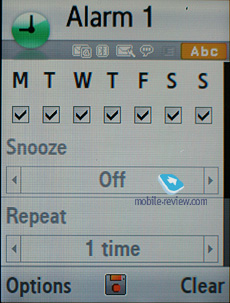
File Manager (My files). That’s the place to search for all files such as music, pictures, video and sounds. Any uploaded file gets stored here. The disadvantage is that files sometimes are not displayed in the list immediately - in that case you will need to leave the menu and enter it again.
Files and folders can be viewed either as a list or thumbnails. You can mark any number of files. The handset supports Move, Copy and Delete operations, as well as various types of sorting (by type, name or size).
Memory card’s file structure is a slightly different story, as it can be accessed through the main menu, where each item features “Memory card” option.
Settings. Traditionally this item boasts a standard set of options inside like password protection of selected sections (messages, short messages, organizer, etc.), backlighting duration and brightness, dialing display settings (no custom animations are available, one is assigned to the default theme – uWorld).
Keypad light – there are three options at your disposal, one of them is Night mode, implying that backlighting will be active only between 5:00 PM and 9:00 AM and disabled during daytime. If you come to think of it, this feature is nothing more but an illusive replacement for ambient light indicator, which Motorola’s handsets are armed with.
My Screen. Apart from the standard and run-of-the-mill set of wallpapers for the standby screen, you can make up animated wallpapers of your own, and it doesn’t take a rocket scientist to create one. All you need are 9 snaps, then you adjust time spans between different frames and transition effects (there is a slew of them available, like Butterfly, Paper place etc). And the animation you get is pretty amusing; it will work on the standby screen as long as the display is on..
Profiles – the F330 comes with a fully functional system of profiles, including Flight Mode. Every profile is customizable – you can pick ring tone, incoming message alert and adjust the volume level.
Mobile Tracker – submit a phone number, where notifications will be sent to in case SIM-card was changed – that message will contain number of the SIM-card being used with the handset. This section is protected with password, so that no one other than you or someone else who knows the password could disable the Tracker. Should your device have the SIM-card switched once, the specified number will receive one message instantly, and one more each time a new card is plugged in. A fetching feature which can prove to be of much help in case the handset is lost or stolen.
Slide action settings item features options which can be assigned to opening and closing. In other words, they determine whether the slider is active or not.
You can setup the music player with a special Wizard, which guides you through only 4 steps, so it doesn’t seem to be really required on the F330.
Back to the table of contents >>>
Impressions
The reception quality put up by the F330 is in line with other Samsung-branded devices. The ringtone volume is quite decent, as it can be heard in various environments. The silent alert is average strength-wise, no significant improvements have been made here.
Form-factor wise, the F330 appears to be a rival to the Sony Ericsson W910i, but on closer examination, you’ll see that these are two completely different worlds. In terms of price, the Samsung’s offspring is more of a competitor to the Sony Ericsson W580i. However the latter is a clear winner thanks to a bevy of color solutions, more punch under the hood, better build quality and materials used (the plastic utilized in the W580i is way more expensive). Given their equally heavy price tags of 400 USD, these two are going to clash, but don’t expect the F330’s sales to come close to the benchmark of the W580i. The reason being that it already has another competitor in the form of the Samsung U600 with its superior 3,2 Mpix camera and similar price, making the F330 not a clear-cut choice. Consumers are more likely to go for a device from the U-series instead of a quirky handset housed in an unsophisticated design.
One of the company’s missteps with the F330 is the decision to offer it only in white, which instantly narrows down its target audience, making this phone a very niche model. The youth won’t find this trim flashy enough, however girls usually deem this color appealing. On the other hand, the absence of a 3,5 mm audio jack on the casing, its sound quality comparable with other offerings and not exactly snazzy design might put these girls off. All this throws the F330 into a vicious circle which it doesn’t seem to be capable to escape from.
I had been struggling for a while, trying to figure out what this phone lacks and what could outweigh most of its omissions, but the answer turned out to be right on the surface – my friend’s 17-year old daughter enlightened me “I wouldn’t buy it – it lacks style, but pretends to be an iPod”. This phone definitely needs more charisma.
Related links
Back to the table of contents >>>
Eldar Murtazin ([email protected])
Translated by Oleg Kononosov ([email protected])
Published — 29 November 2007
Have something to add?! Write us... [email protected]
|
News:
[ 31-07 16:21 ]Sir Jony Ive: Apple Isn't In It For The Money
[ 31-07 13:34 ]Video: Nokia Designer Interviews
[ 31-07 13:10 ]RIM To Layoff 3,000 More Employees
[ 30-07 20:59 ]Video: iPhone 5 Housing Shown Off
[ 30-07 19:12 ]Android Fortunes Decline In U.S.
[ 25-07 16:18 ]Why Apple Is Suing Samsung?
[ 25-07 15:53 ]A Few Choice Quotes About Apple ... By Samsung
[ 23-07 20:25 ]Russian iOS Hacker Calls It A Day
[ 23-07 17:40 ]Video: It's Still Not Out, But Galaxy Note 10.1 Gets An Ad
[ 19-07 19:10 ]Another Loss For Nokia: $1 Billion Down In Q2
[ 19-07 17:22 ]British Judge Orders Apple To Run Ads Saying Samsung Did Not Copy Them
[ 19-07 16:57 ]iPhone 5 To Feature Nano-SIM Cards
[ 18-07 14:20 ]What The iPad Could Have Looked Like ...
[ 18-07 13:25 ]App Store Hack Is Still Going Strong Despite Apple's Best Efforts
[ 13-07 12:34 ]Infographic: The (Hypothetical) Sale Of RIM
[ 13-07 11:10 ]Video: iPhone Hacker Makes In-App Purchases Free
[ 12-07 19:50 ]iPhone 5 Images Leak Again
[ 12-07 17:51 ]Android Takes 50%+ Of U.S. And Europe
[ 11-07 16:02 ]Apple Involved In 60% Of Patent Suits
[ 11-07 13:14 ]Video: Kindle Fire Gets A Jelly Bean
Subscribe
|

























